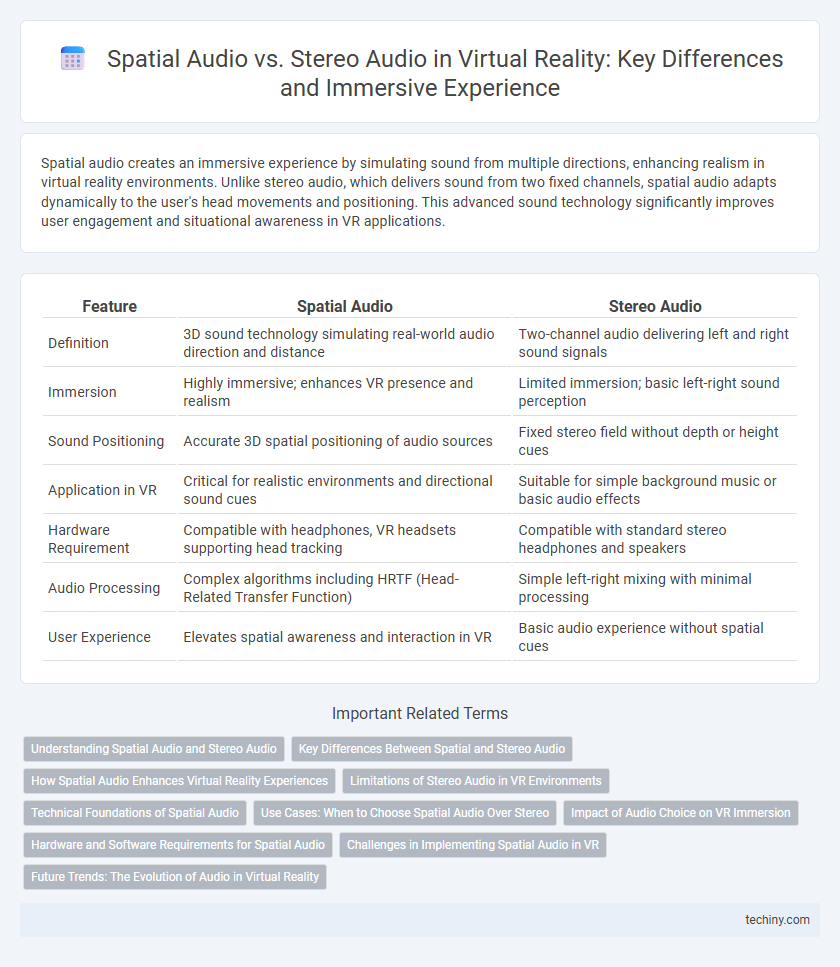Spatial audio creates an immersive experience by simulating sound from multiple directions, enhancing realism in virtual reality environments. Unlike stereo audio, which delivers sound from two fixed channels, spatial audio adapts dynamically to the user's head movements and positioning. This advanced sound technology significantly improves user engagement and situational awareness in VR applications.
Table of Comparison
| Feature | Spatial Audio | Stereo Audio |
|---|---|---|
| Definition | 3D sound technology simulating real-world audio direction and distance | Two-channel audio delivering left and right sound signals |
| Immersion | Highly immersive; enhances VR presence and realism | Limited immersion; basic left-right sound perception |
| Sound Positioning | Accurate 3D spatial positioning of audio sources | Fixed stereo field without depth or height cues |
| Application in VR | Critical for realistic environments and directional sound cues | Suitable for simple background music or basic audio effects |
| Hardware Requirement | Compatible with headphones, VR headsets supporting head tracking | Compatible with standard stereo headphones and speakers |
| Audio Processing | Complex algorithms including HRTF (Head-Related Transfer Function) | Simple left-right mixing with minimal processing |
| User Experience | Elevates spatial awareness and interaction in VR | Basic audio experience without spatial cues |
Understanding Spatial Audio and Stereo Audio
Spatial audio creates a three-dimensional sound environment by simulating how sound waves interact with the listener's position and surroundings, enhancing immersion in virtual reality experiences. Stereo audio delivers sound through two channels, left and right, providing basic directional cues but lacking depth and positional accuracy. Understanding spatial audio's ability to mimic real-world hearing improves VR realism and user engagement compared to traditional stereo audio.
Key Differences Between Spatial and Stereo Audio
Spatial audio creates an immersive 3D sound experience by accurately simulating how sound waves interact with the environment and reach the listener's ears from different directions, enhancing realism in virtual reality settings. Stereo audio, by contrast, utilizes two separate channels to deliver sound primarily from left and right speakers, providing a sense of width but lacking depth and directional cues. Key differences include spatial audio's ability to replicate sound localization and distance perception, which stereo audio cannot achieve, making spatial audio essential for fully immersive VR experiences.
How Spatial Audio Enhances Virtual Reality Experiences
Spatial audio creates an immersive environment by accurately mimicking sound direction, distance, and movement, which stereo audio cannot replicate. This 3D sound positioning enables users in virtual reality to identify audio cues from all around, significantly increasing realism and presence. Enhanced spatial awareness through spatial audio improves user interaction and emotional engagement within VR environments.
Limitations of Stereo Audio in VR Environments
Stereo audio in virtual reality environments fails to provide accurate spatial cues, limiting the sense of immersion by delivering sound from only two fixed channels. This results in a reduced ability to perceive the direction and distance of audio sources, impairing situational awareness and user experience. Unlike spatial audio, stereo audio cannot simulate realistic 3D soundscapes essential for true VR presence.
Technical Foundations of Spatial Audio
Spatial audio leverages binaural rendering and Head-Related Transfer Functions (HRTFs) to accurately simulate sound localization in a 3D environment, enhancing immersion in virtual reality experiences. Unlike stereo audio, which uses two fixed channels for left and right ears, spatial audio dynamically adjusts sound cues based on user head movements and environmental context. This technical foundation enables precise perception of distance, direction, and movement of sound sources, critical for realistic VR applications.
Use Cases: When to Choose Spatial Audio Over Stereo
Spatial audio enhances VR experiences by delivering 360-degree sound positioning, making it essential for immersive gaming, virtual tours, and training simulations where directional audio cues improve realism and presence. Stereo audio remains suitable for simpler applications like basic media playback or situations where spatial orientation is less critical, such as casual VR viewing or non-interactive content. Choosing spatial audio over stereo depends on the need for accurate sound localization and environmental immersion in the virtual environment.
Impact of Audio Choice on VR Immersion
Spatial audio enhances VR immersion by delivering 3D sound that mimics real-world audio cues, allowing users to accurately perceive direction and distance. Stereo audio, limited to two channels, fails to provide the same depth and positional awareness, reducing the sense of presence within virtual environments. Implementing spatial audio significantly increases user engagement and realism, making it essential for high-quality VR experiences.
Hardware and Software Requirements for Spatial Audio
Spatial audio requires advanced hardware such as multi-channel speakers, binaural headphones, or specialized VR headsets with integrated HRTF (Head-Related Transfer Function) processing to deliver immersive 3D soundscapes. Software needs include spatial audio engines capable of real-time audio rendering, environmental acoustic modeling, and dynamic sound source localization, often supported by middleware like Steam Audio or Oculus Audio SDK. Compared to traditional stereo audio, spatial audio demands higher processing power and precise sensor integration to synchronize audio cues with user head movements for accurate sound positioning.
Challenges in Implementing Spatial Audio in VR
Implementing spatial audio in VR presents challenges including accurate real-time sound localization, complex audio processing that demands significant computational resources, and the integration of head-tracking data to ensure immersive sound positioning. Unlike stereo audio, which simply delivers two-channel sound, spatial audio must simulate three-dimensional sound environments, requiring advanced algorithms to model how sound waves interact with the listener's position and movements. Overcoming latency issues and ensuring consistent audio quality across different VR hardware further complicate the development process.
Future Trends: The Evolution of Audio in Virtual Reality
Spatial audio in virtual reality enhances immersion by simulating 3D sound environments, surpassing traditional stereo audio that limits audio cues to two channels. Future trends emphasize advanced binaural rendering, real-time head-tracking, and AI-driven soundscapes that adapt dynamically to user interactions. These innovations aim to create hyper-realistic auditory experiences, crucial for next-generation VR applications in gaming, training, and virtual meetings.
Spatial audio vs Stereo audio Infographic

 techiny.com
techiny.com